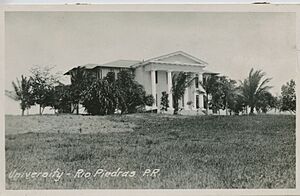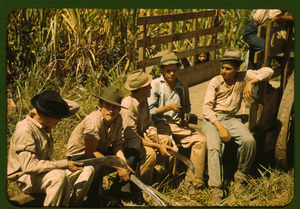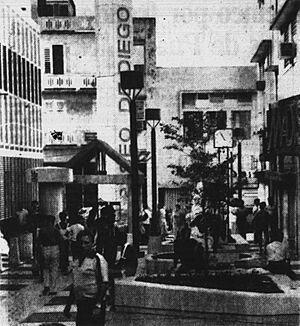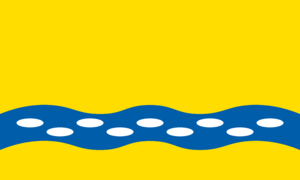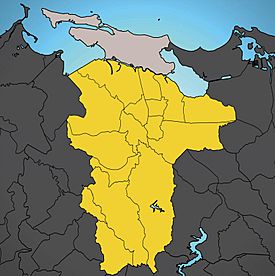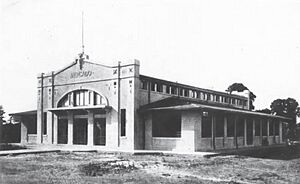Río Piedras, Puerto Rico facts for kids
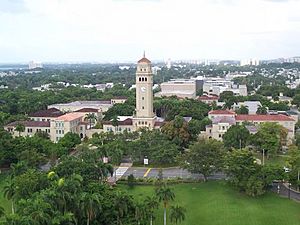
Río Piedras is a busy area in San Juan. It used to be a separate town and municipality in Puerto Rico. In 1951, it became part of San Juan. Today, Río Piedras is made up of different neighborhoods called barrios, like Pueblo and Universidad.
The town was first started in 1714 and was called El Roble. It became an official municipality in 1823. Since 1903, it has been home to the main campus of the University of Puerto Rico. Because of this, many people call it Ciudad Universitaria, which means "University City." The old downtown area of Río Piedras is now known as the Pueblo barrio of San Juan.
Contents
What Does Río Piedras Mean?
The name Río Piedras means "Stone River." It is the name of a river that flows through the area. Río Piedras was also the name of the former municipality from 1823 to 1950.
A Look at Río Piedras History
Long ago, the Taíno people lived in the area where Río Piedras is now. Scientists have found old Taíno sites nearby. The town was officially started in 1714 by Spanish Governor Juan de Rivera. It was built where the Piedras River and the Juan Méndez Creek met. The town later took the river's name, Río Piedras. In 1823, it became a municipality, and they built a city hall and a main town square called a plaza.
During the 1800s, most of the land was used for farming and raising animals. Farmers grew crops like sugar cane, cotton, and coffee. A road was built to connect Río Piedras to San Juan. The first church, Iglesia Nuestra Señora del Pilar, was also built then. Río Piedras became an important trading spot because it was on the main road between San Juan and the rest of the island.
The University of Puerto Rico opened in Río Piedras on May 12, 1903. It used money from an old school. Today, the University of Puerto Rico, Río Piedras Campus is one of the biggest universities in Puerto Rico. The university helped Río Piedras grow with new businesses and homes. The University Botanical Gardens are also in Río Piedras.
Río Piedras Joins San Juan
On July 1, 1951, the municipality of Río Piedras became part of San Juan. This happened after a plan called Project 177 was approved. After Río Piedras joined, San Juan became four times bigger. In 1950, Río Piedras had 143,989 people, making it the most populated municipality in Puerto Rico before it merged with San Juan. The last mayor of Río Piedras was Ángeles Méndez de López Corver. The old downtown area is now part of the Pueblo barrio of San Juan. It is often called Río Piedras Antiguo (Old Río Piedras) or Río Piedras Pueblo. It still has its old city hall, town square, and cathedral.
The Paseo de Diego
In July 1980, the mayor announced that Calle De Diego, a very busy street in Río Piedras, would become a walking street. This new pedestrian walkway would stretch from Ferrocarril street to Ponce de Leon Avenue. It would also include part of Calle del Carmen. The project was expected to cost about $1.5 million.
On December 5, 1981, the first part of Paseo De Diego was finished. It cost $1,100,000. The walkway had two fountains, four clocks, nice lights, and 42 trees. It looked like an outdoor shopping mall. The Paseo de Diego officially opened on December 18, 1981.
On November 5, 1983, a new shopping center called Plaza de Diego Mall opened on Paseo de Diego. It had three levels and covered 90,000 square feet. The first two levels had 13 stores, and the third level had 13 places to eat.
Symbols of Río Piedras
The Flag
The flag of Río Piedras is yellow with a wavy blue stripe. The blue stripe has small white stones on it. This stripe stands for the river that gave the town its name. The yellow background represents the sun, progress, and a bright future.
Geography and Weather
Río Piedras is mostly flat because it is in the Northern Coastal Plains of the island. The highest parts are in the south, in the Caimito and Cupey neighborhoods. The Río Piedras (or Piedras River) flows through the area.
| Climate data for Río Piedras, Puerto Rico (San Juan Botanical Garden) 1991–2020 normals, extremes 1959–present | |||||||||||||
|---|---|---|---|---|---|---|---|---|---|---|---|---|---|
| Month | Jan | Feb | Mar | Apr | May | Jun | Jul | Aug | Sep | Oct | Nov | Dec | Year |
| Record high °F (°C) | 94 (34) |
95 (35) |
95 (35) |
97 (36) |
97 (36) |
97 (36) |
98 (37) |
98 (37) |
99 (37) |
98 (37) |
95 (35) |
92 (33) |
99 (37) |
| Mean daily maximum °F (°C) | 84.8 (29.3) |
85.5 (29.7) |
86.0 (30.0) |
87.1 (30.6) |
88.5 (31.4) |
90.2 (32.3) |
89.9 (32.2) |
90.4 (32.4) |
90.2 (32.3) |
89.6 (32.0) |
86.8 (30.4) |
85.6 (29.8) |
87.9 (31.1) |
| Daily mean °F (°C) | 75.4 (24.1) |
75.3 (24.1) |
76.0 (24.4) |
77.7 (25.4) |
79.7 (26.5) |
81.0 (27.2) |
81.1 (27.3) |
81.9 (27.7) |
81.4 (27.4) |
80.7 (27.1) |
78.0 (25.6) |
76.6 (24.8) |
78.7 (25.9) |
| Mean daily minimum °F (°C) | 66.0 (18.9) |
65.1 (18.4) |
65.9 (18.8) |
68.3 (20.2) |
70.8 (21.6) |
71.8 (22.1) |
72.3 (22.4) |
73.3 (22.9) |
72.6 (22.6) |
71.8 (22.1) |
69.2 (20.7) |
67.6 (19.8) |
69.6 (20.9) |
| Record low °F (°C) | 50 (10) |
49 (9) |
50 (10) |
60 (16) |
59 (15) |
60 (16) |
60 (16) |
62 (17) |
62 (17) |
60 (16) |
55 (13) |
55 (13) |
49 (9) |
| Average precipitation inches (mm) | 5.47 (139) |
3.42 (87) |
3.95 (100) |
5.55 (141) |
7.52 (191) |
4.59 (117) |
8.02 (204) |
6.92 (176) |
8.30 (211) |
7.04 (179) |
9.72 (247) |
5.39 (137) |
75.89 (1,928) |
| Source: NOAA | |||||||||||||
Neighborhoods of Río Piedras
By 1948, Río Piedras had 12 city neighborhoods, also known as barrios:
- Buen Consejo
- Capetillo
- El Cinco
- Gobernador Piñero
- Hato Rey Central
- Hato Rey Norte
- Hato Rey Sur
- Oriente
- Río Piedras Antiguo
- Sabana Llana Norte
- Sabana Llana Sur
- Universidad
Buen Consejo, Capetillo, and Río Piedras Antiguo were the first city areas of Río Piedras.
The countryside, which was 42% of Río Piedras in 1948, had six rural barrios:
- Caimito
- Cupey
- Monacillo
- Quebrada Arenas
- Sabana Llana Rural
- Tortugo
Population Changes
| Historical population | |||
|---|---|---|---|
| Census | Pop. | %± | |
| 1900 | 13,760 | — | |
| 1910 | 18,880 | 37.2% | |
| 1920 | 23,035 | 22.0% | |
| 1930 | 40,853 | 77.4% | |
| 1940 | 68,290 | 67.2% | |
| 1950 | 143,989 | 110.8% | |
| U.S. Decennial Census 1899 (shown as 1900) 1910–1930 1930–1950 1960–2000 2010 |
|||
Fun Places to Visit
Some interesting places to visit in Río Piedras include:
- The Río Piedras campus of the University of Puerto Rico. You can see its theater, bell tower, and museums.
- Casa de Cultura Ruth Hernández Torres, a cultural center.
- Heladería Georgetti, a famous ice-cream shop.
- El Churro Bar, a popular Mexican restaurant.
- Plaza del Mercado de Río Piedras, the old market building in downtown Río Piedras.
- El Boricua, a popular spot for both locals and visitors.
Education in Río Piedras
Río Piedras is well known for being home to the main campus of the University of Puerto Rico. This university is in downtown Río Piedras and has over 20,000 students and more than 1,000 teachers.
Other universities in the area that was once Río Piedras include the Polytechnic University of Puerto Rico and the Interamerican University of Puerto Rico, Metropolitan Campus.
Río Piedras also has many public and private schools. The Puerto Rico Department of Education manages the public schools.
Getting Around Río Piedras
Río Piedras has its own Tren Urbano (city train) stations. These are the University of Puerto Rico station and the Río Piedras station in downtown. Many other train stops in San Juan are also in areas that were part of Río Piedras before 1951.
Culture and Life
At the heart of Río Piedras is Avenida José de Diego, a one-kilometer-long street where only people can walk. It is full of stores and shops. The Río Piedras Plaza del Mercado (the old market) is the biggest of its kind in Puerto Rico. It has many shops selling goods and services and is popular with university students.
Ponce de León Avenue is known for its bookstores and small theaters. It is a favorite spot for students, teachers, and thinkers in the community.
Famous People from Río Piedras
- Luis Torres Díaz
- La India
- Tito Nieves
- Joaquin Phoenix
- Frank H. Wadsworth
Images for kids
-
Iglesia Nuestra Señora del Pilar in Río Piedras Pueblo.
-
Historic Casa Georgetti in Pueblo.
See Also
 In Spanish: Río Piedras (Puerto Rico) para niños
In Spanish: Río Piedras (Puerto Rico) para niños


